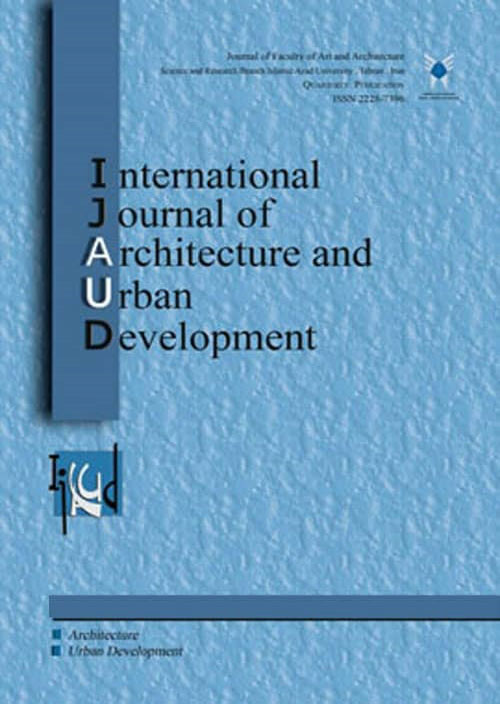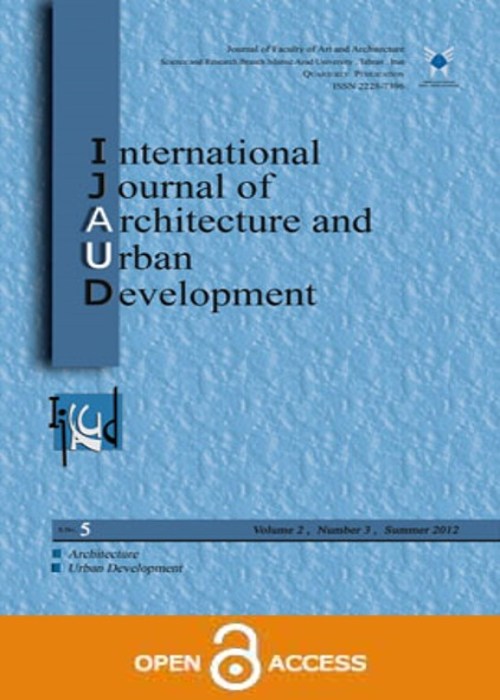فهرست مطالب

International Journal of Architecture and Urban Development
Volume:10 Issue: 4, Autumn 2020
- تاریخ انتشار: 1399/07/09
- تعداد عناوین: 6
-
-
Pages 1-18The histories of architectural design and town planning are replete with references to creating a better quality of human life. One of the approaches to enhancing human existence is Vāstu Vidyā, the knowledge of design and building from the ancient Vedic tradition. More recently, Vāstu Vidyā has been repurposed to include not only architectural practice and construction but also considered in light of the consciousness of the designer and builder and the need for a more ‘enlightened’ approach to design. Such a consideration is called Maharishi Vedic Architecture (MVA). Some of the features of MVA include a concern for orientation of the building to cardinal east, the position and proportion of rooms within the dwelling, and considerations of slope and relation to the early morning sun. Such features are said to enhance the creativity, health, and happiness of occupants. The purpose of the present study is to explore the experiences of individuals who reside in homes designed according to the principles of MVA. Triangulated quantitative and qualitative results from an international mixed-methods survey of 158 individuals in 14 countries indicate this approach to architectural design contributes to individual and family quality of life, specifically as it has been operationalized to mean changes in well-being, health, personal development, and success. On a quality-of-life scale, the study found a statistically significant difference between those living in MVA for more than three years compared to those living in MVA for less than three years (F = 1.89, p = .02), however no difference was observed between experiences for people living in different locations.Keywords: Maharishi Vedic Architecture, quality of life, Vāstu, lived experience, mixed methods research
-
Pages 19-28The appearance of Square in Northwest Iran, as a traditional element of the city, did not have a certain definition in the urban planning due to its structural disruption in the spatial fabric as well as its chaotic present in the manifestation of its identity. On the other hand, since the concept of the square in this area does not match to the similar models existing in the central plateau of Iran including the characteristics of being enclosed and architectural integrity, most researchers have assumed that the irregularity of the form in the squares of northwest Iran is because of gradual growth, lack of spatial desirability, and performance without a predesigned plan. This descriptive-analytic research studies the effect of climate on the formation of the structural layout of "Saheb Abad" Square as a case study. In this way, a specified framework would be suggested, and a fixed sustainable urban pattern would be achieved regarding the form of a square in modern urbanism in this region. According to the findings of this study, the disintegrated layout of the square in Northwest Iran is not only because of its structural weakness, but it was in certain parallels with environmental and natural conditions. It is obvious that the investigation of this innovation could lead to sustainable development in modern urban constructions.Keywords: Turkman era, Square, Sustainable development, Cold Climate, Northwest Iran
-
Pages 29-38Architectural education requires efficient methods to demonstrate its efficiency to meet the quantitative and qualitative needs derived from modern socio-economic development. In architectural education, the ability to design is an essential part and the main goal of education. Looking at the various methods and patterns related to architectural education and the type and content of instruction in architecture, one can observe the necessity of choosing or designing a model of thinking to teach skilled courses, including practical workshops in schools of architecture, institutions, and colleges. In this study, the relationship between emotional intelligence and creativity has been examined. Depending on the educational system structure, this examination can improve the educational infrastructure, because the main function of the educational system is self-awareness of students regarding their personality. Students, by recognizing multiple intelligences, can gain the necessary confidence to be creative and self-fulfilling. Although less attention has been paid to identifying and developing creativity in our education system, it is necessary to scrutinize the processes of emotional intelligence and creativity and to examine the effective factors. In the present study, the standard tools for measuring and collecting information, were the Torrance Creativity Questionnaire Test, Gardner's Multiple Intelligence Test, and the Academic Improvement Test before and after training. In order to analyze the data and test the hypothesis, the methods used were Delphi's expert method, correlation test, covariance, and T-test in SPSS software.Keywords: architectural education, Creativity, emotional intelligence, Torrance Creativity Test
-
Pages 39-48The study examined the quantity and quality of infrastructure in Ibadan, Nigeria with a view to using information to providing policy guidelines for sustainable infrastructural development. Using stratified sampling technique, a total of fifteen wards from the five local government areas in Ibadan metropolis were selected for study. The selection of all the local government areas is based on the fact that all of them cut across all the residential zones in the metropolis and them all spatially coverage at the centre of the city. Primary data for the study were collected through the questionnaire administered on 1,035 respondents (2% of household heads in all the residential buildings in the metropolis), using systematic sampling technique. Descriptive and inferential statistics were employed to analyse the data obtained. Findings showed that deviations about the mean of the satisfaction index of the facilities such as church and dispensary were higher than their respective FAI. Furthermore, findings revealed that these infrastructural facilities were very adequate to the residents, but the residents were not satisfied with their adequacy in the study area. These facilities were mosque, nursery/primary school and secondary school. This implied that these facilities were available and adequate to greatly satisfy the residents. Thus, the study concluded that infrastructure facilities in Ibadan metropolis were fair.Keywords: Satisfaction, Infrastructure, adequacy, facilities, residents
-
Pages 49-56The concept of sustainability is encouraged to preserve natural resources, social values, cultural heritage, and economic capital, which already exist to make available them for the next generations. Moreover, to enhance the level of sustainability in communities, numerous scholars indicated both individual and community identities play a crucial role. Sustainability is attainable and successful if there are compatibility and balance among cultural diversity, social justice, environmental responsibility, and economic equality as well as be able to attract people and appeared in their values and behaviors. Due to the critical role of social identity for improving the capacity of the people by changing their values and behaviors, it can be argued that social identity plays a vital role to achieve and support the concept of sustainability. Besides, place identity is linked to meanings and perceptions held by the people concerning their environment. Thus, the effect of social and place identities to achieve sustainable city has been identified as one of the urban design issues for contemporary cities. In this regard, the main aim is how social and place identities can contribute to promoting sustainability approaches and behavior in communities. The methodology of this study is an integrative literature review based on existing documents and studies. As a result, the research would convey to understanding the dynamic role of social and place identities for enhancing the level of sustainability in urban communities.Keywords: Sustainability, Identity, social identity, Place Identity, city-identity-sustainability
-
Pages 57-66
The sociability and quality of behavior settings, according to general psychology data, are the most significant environmental values, measuring which helps to assess the success of environmental and architectural aspects. The present study was aimed at investigating the efficient environmental characteristics for the achievement of sociability in educational space. This issue has been addressed by examining the type and manner of interactions of students at the University of Tehran as well as qualified environmental factors facilitating, or restricting these interactions. In this study, data were collected as a combination of three methods of interview, observation, and questionnaire; with a population of students at the University of Tehran. With regards to statistical investigations, the sample size was 386 taken with a simple random sampling, and the data were analyzed using SPSS22 software. The one-sample t-test was also used for data analysis in order to find a logical relationship between variables. The results have shown that all environmental indicators are of significant importance for students in the formation of social interactions between students.
Keywords: social interaction, Architectural Aspects, Environmental Affordance, Tehran University, Student Sociability


